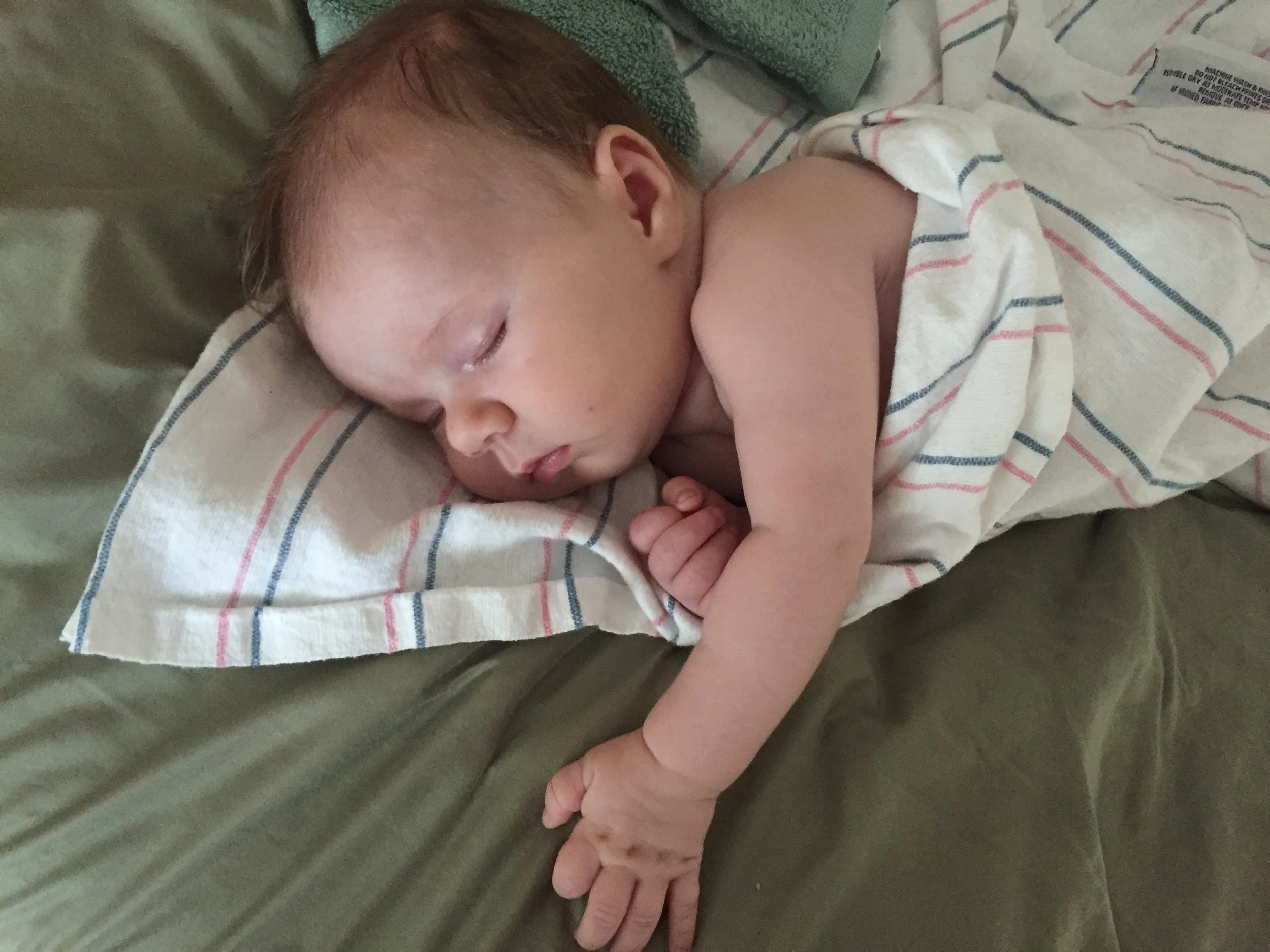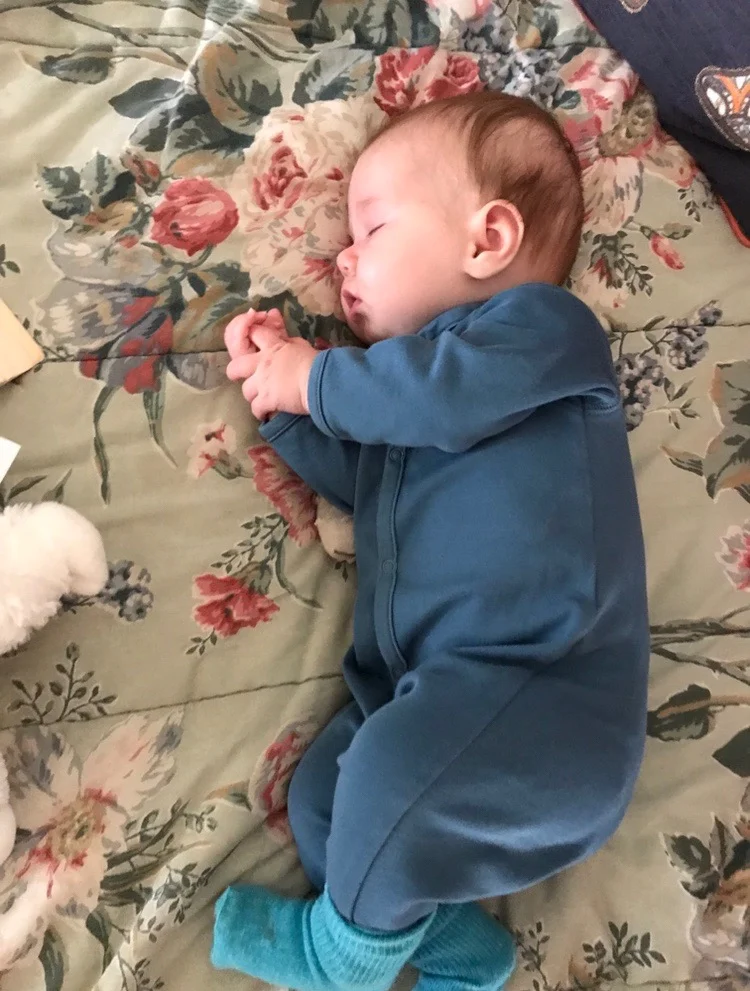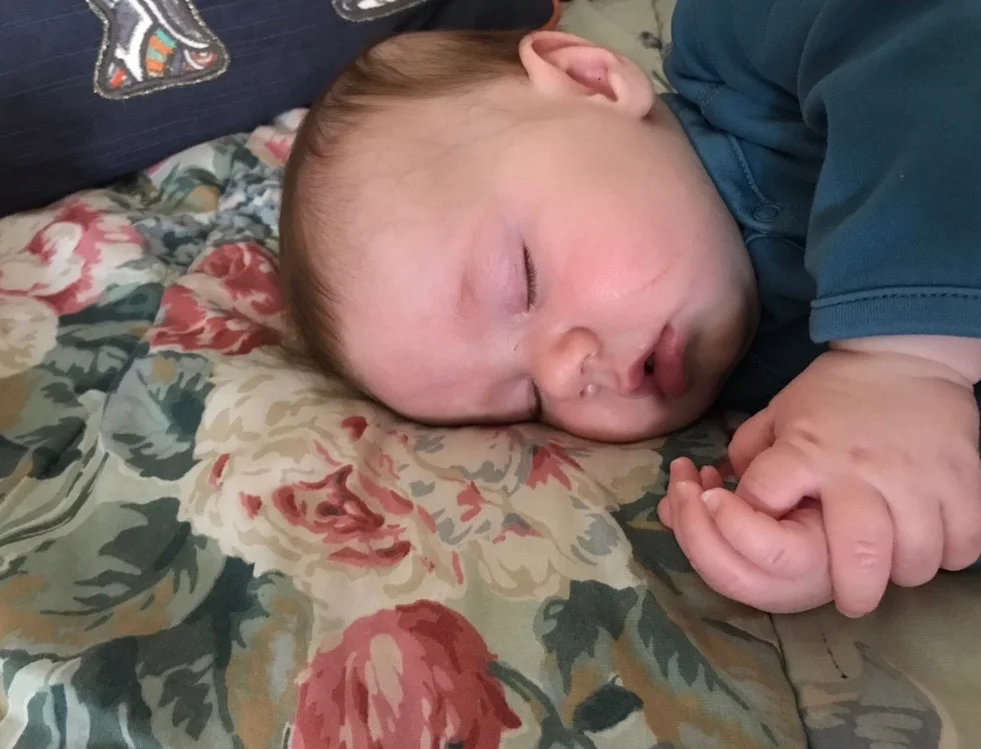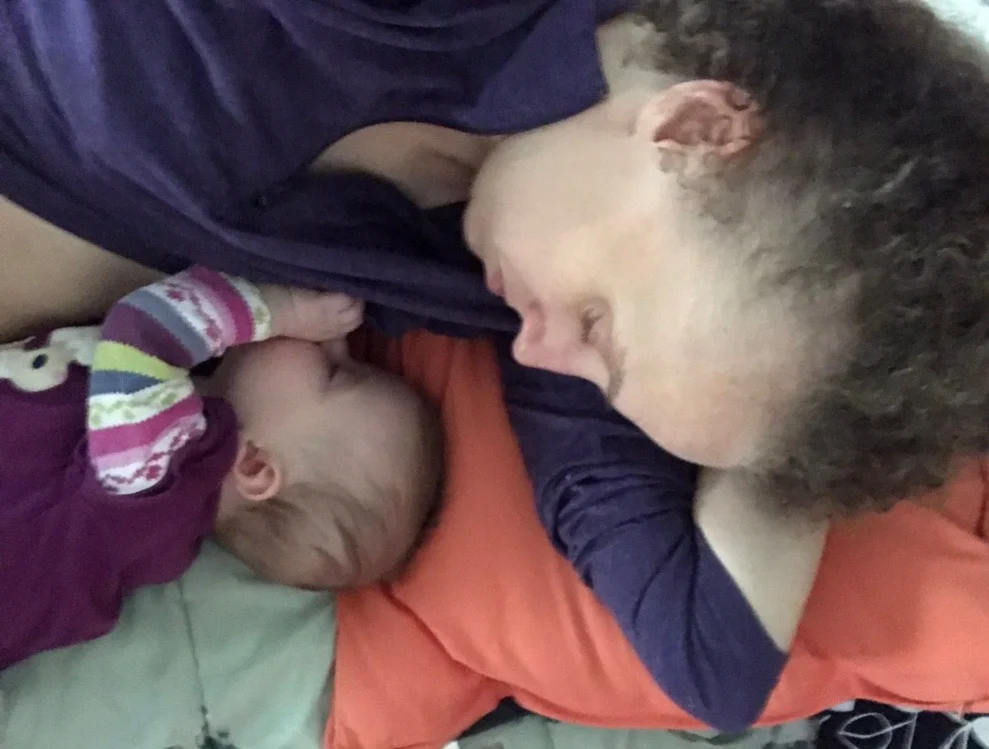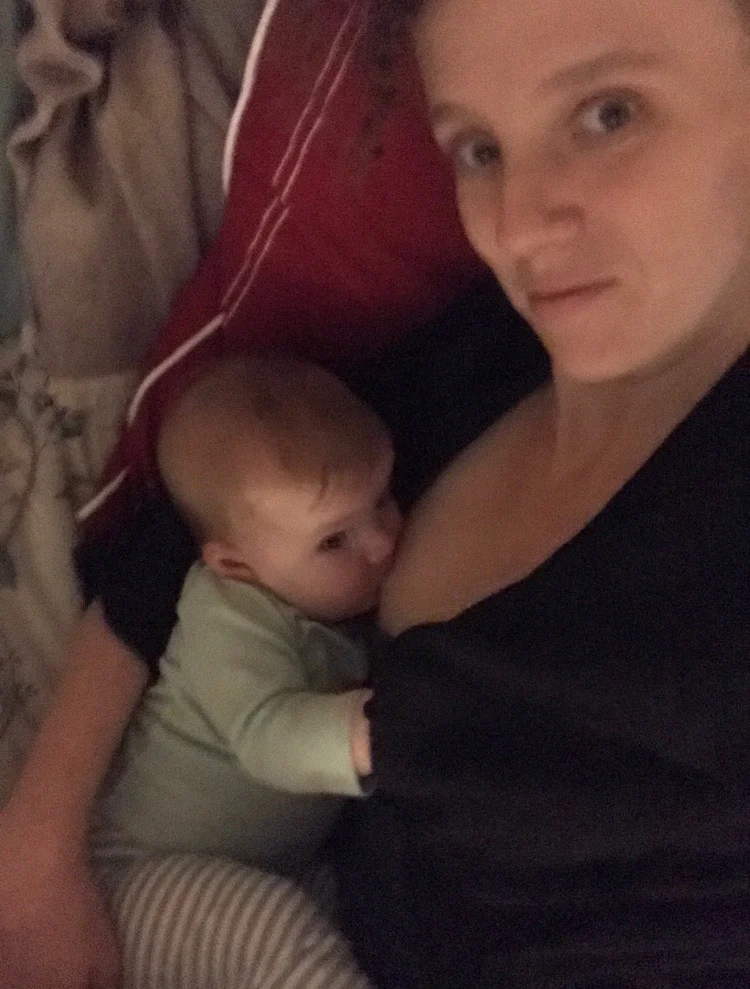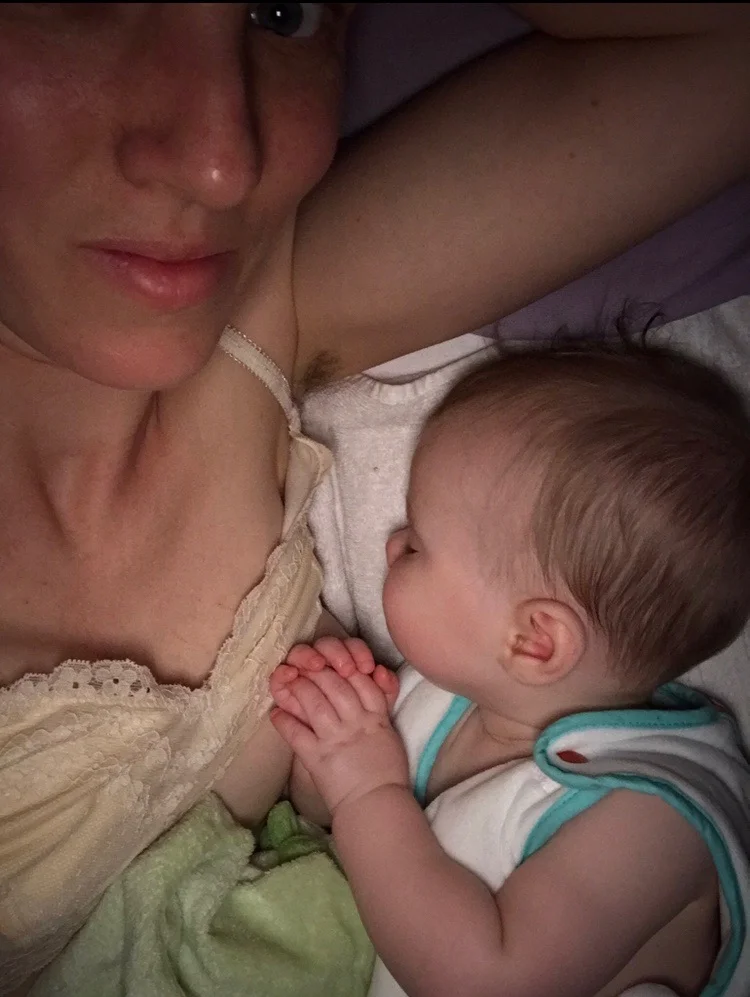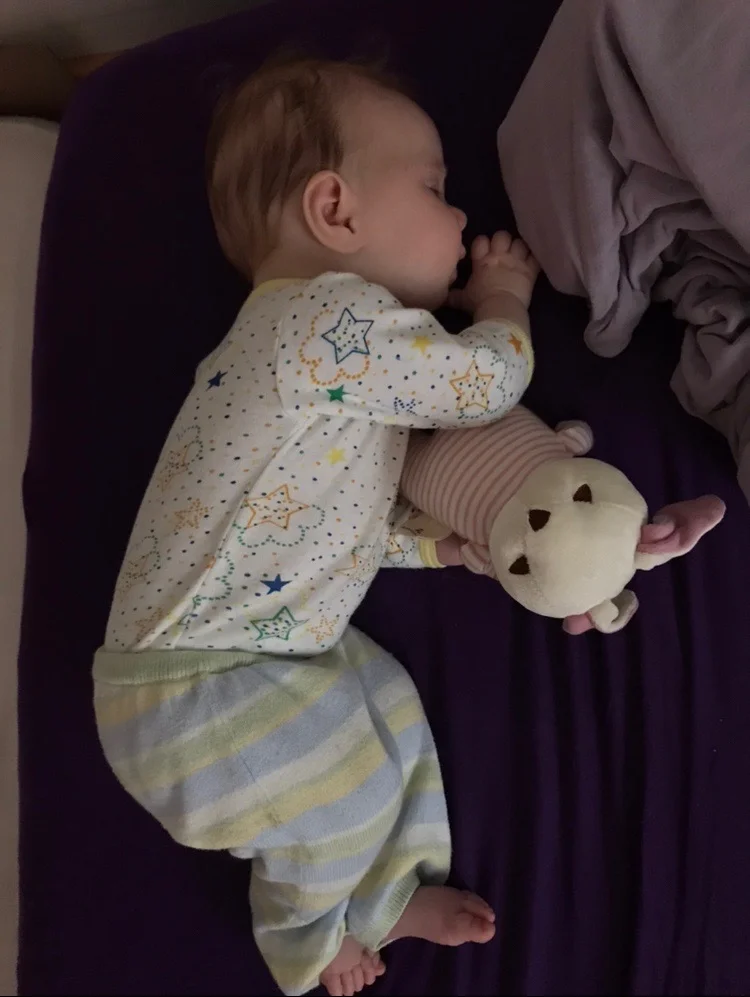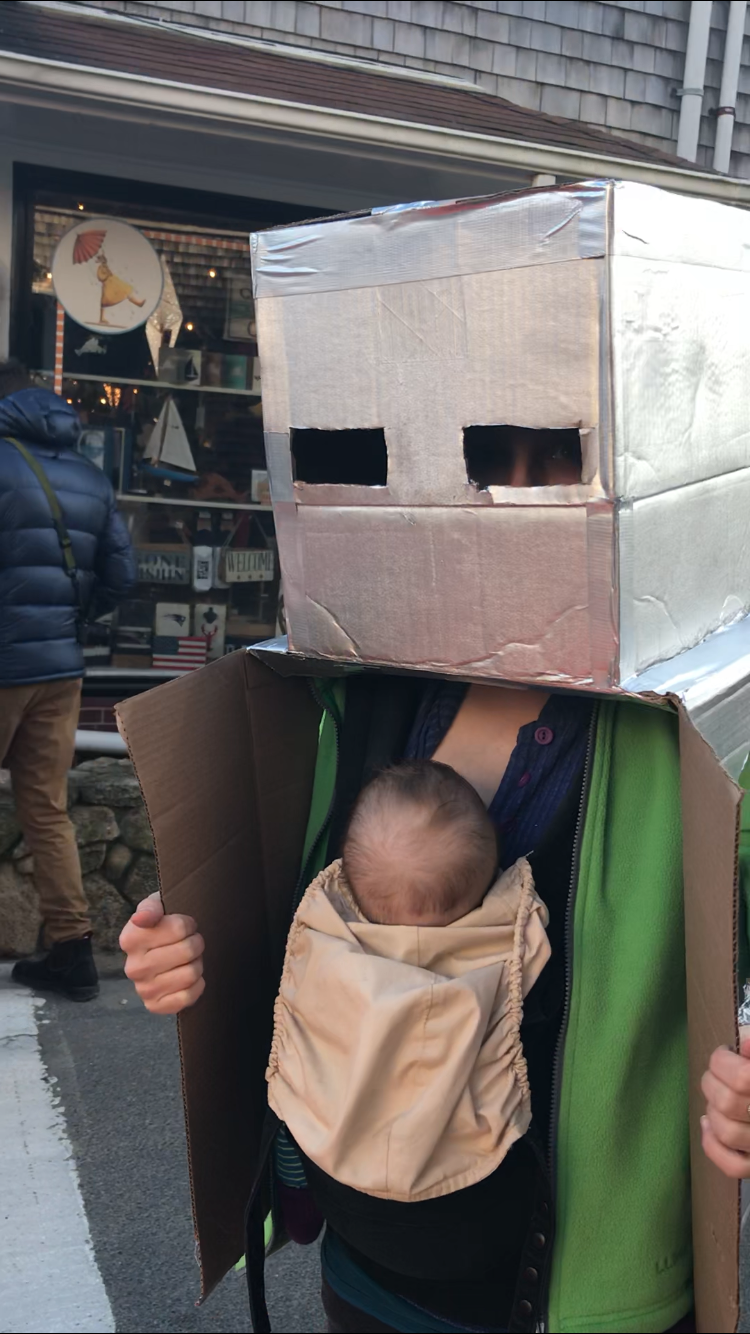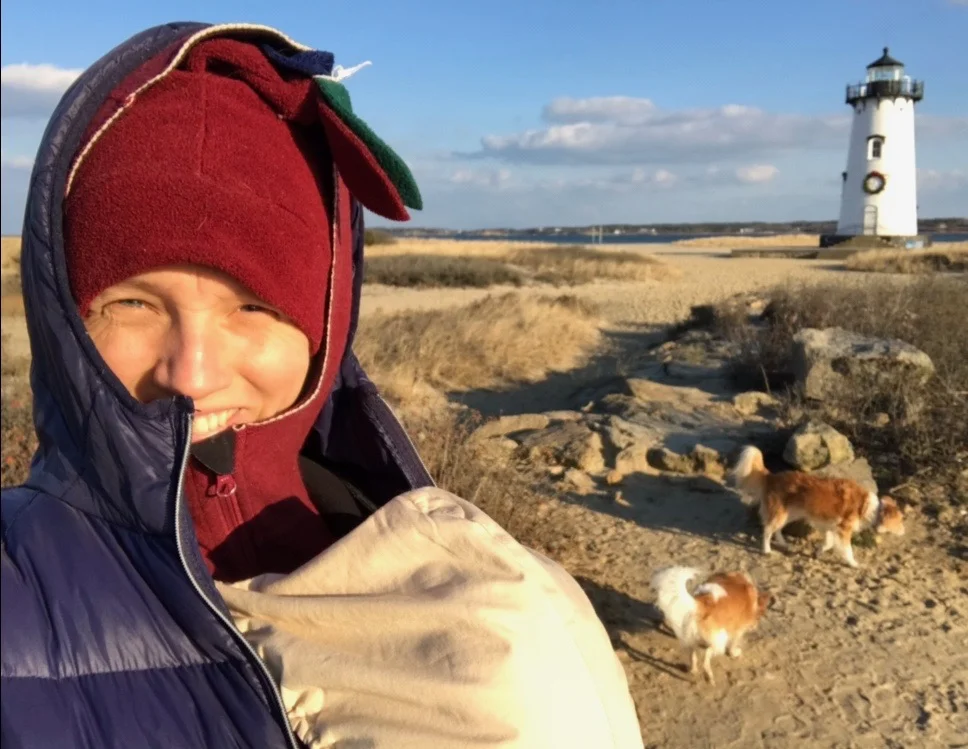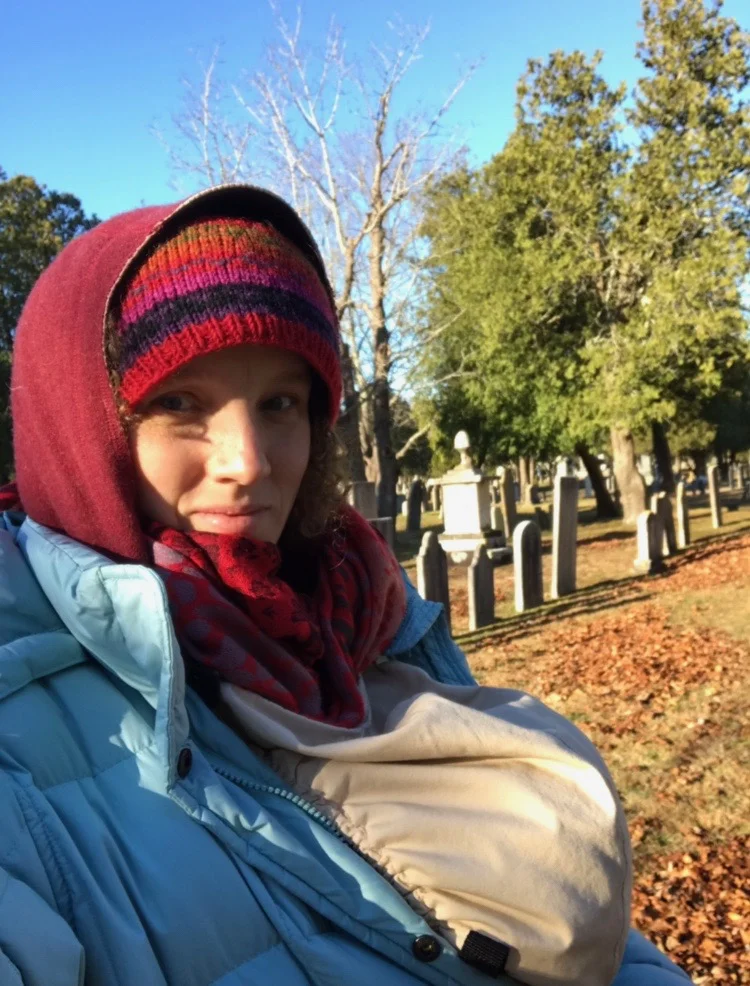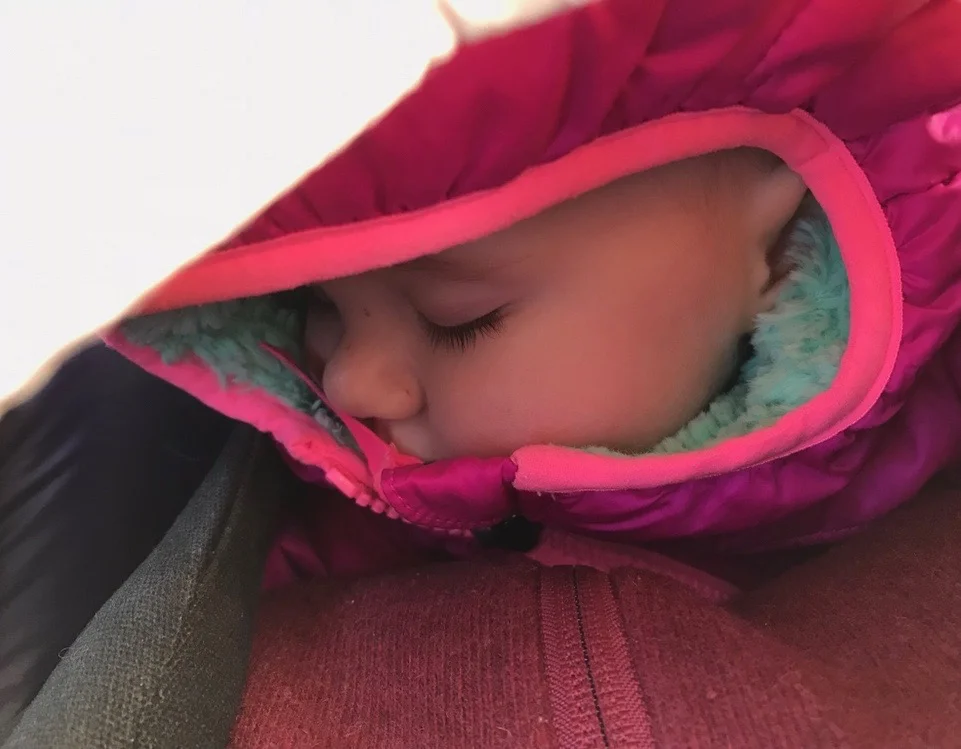SLEEP! What a big topic, a never ending source of discussion and contention among parents. All I can offer here is what worked for me and my baby on our constantly evolving sleep journey.
The First 2 Months:
In the very beginning my baby (like many babies) just slept whenever she needed to and wherever she was. I have photographic proof that I can hardly believe is real now when I look back. There are pictures of her sleeping in a brightly lit room surrounded by talking people, sleeping in the car seat on the floor, sleeping in her basinet with sunlight streaming in the window, sleeping on a blanket under an umbrella at the beach, sleeping outdoors in my arms during a walk, sleeping soundly tucked like a newspaper under her fathers arm. The reason I look back at those photos with disbelief is because SLEEP CHANGES! Those first two months were so easy I realize now. I hardly had to do anything to help her sleep because she just fell asleep constantly. One time I had to get something from a high shelf in the garden shed so I laid her down for a second on my coat and when I turned around she was fast asleep!
Asleep at an outdoor performance of Hamlet age 2 months
*A word about COLIC: I know many babies (and parents) experience the mysterious diagnosis of “colic”. A miserable and little understood phase which some babies go through that involves lots of unexplainable and un-soothable crying, wailing and screaming and very little sleep. For whatever reason my baby didn’t go through that period but friends of mine really suffered with their babies through the first several months and if yours is having a hard time I recommend Dr.Weissbluth’s book “Healthy sleep habits, Happy child” which has whole sections of research and recommendations dedicated to the colicky baby.*
3rd month
In the third month of my babies life I began doing some reading and research about baby sleep and I learned the first important guideline for sleep:
RULE #1 Put baby down drowsy but awake!
According to most sleep researchers the best thing I could do to help my baby learn how to fall asleep by herself was to give her as many opportunities as I could for her to practice. Seems obvious right? This meant that many times a day I would lay her down on her blanket or in her bassinet or on the floor while she was awake and I would let her gaze about and wiggle and coo and entertain herself while I made lunch or washed dishes. Inevitably she would suddenly go quiet and I would look over and see that she had fallen asleep! It was so easy! I felt victorious each time as my baby practiced falling asleep by herself. I thought I had cracked the code, put the baby down “drowsy but awake” the books said, and it worked like a charm!
Then she turned 3.5 months old and things started to get a bit more complex. Sometimes she would still just fall asleep when I put her down but sometimes she would start to cry and I had read that baby’s under 4 months shouldn’t be left to cry by themselves for more than 60 seconds at a time because of their undeveloped ability to cope with rising stress hormones (cortisol). By this time I had read and researched some more and had learned
RULE #2 Awake for no longer than 90 minutes!
This research showed that young babies should optimally only be awake for 90 minutes at a time (1.5 hours) because that is their “sleep window” past which it becomes harder and harder for them to relax and fall asleep easily. So during the day I began to keep track of the time. I would make a note in my phone of the time when she woke from sleep and then I would watch the clock. 60 minutes (1 hour) after my baby woke up I would begin to downshift towards sleep and make it easier for her to fall asleep. If we were at home I would stop playing with her and start being quieter. If we were out doing errands I would try to finish up what we were doing so we could be driving in the car or walking in the pouch or back home in bed by the time 90 minutes rolled around. The desire to make sure that my baby was getting enough sleep over rode my desire to teach her to fall asleep independently. When she didn’t get enough sleep she seemed to lose her bubbly, fun personality and sense of humor and become a flat and serious person more prone to whining. So If my baby didn’t fall asleep on her own then I would go back to her and nurse her until she fell asleep. Thus without even realizing I was doing it I began a new sleep association: Nursing to sleep.
Rule #3 Create Positive Sleep Associations
A sleep association is anything your baby associates with the process of falling asleep and a positive sleep association is one that helps your baby to Help themselves! This means that most of the techniques, tricks and methods that we tired parents resort to (bouncing, rocking, singing, stroking, nursing, bottles, motorized swings and musical toys, driving, carrying, stroller walks etc. are ultimately Unhelpful or negative because they require assistance or input from someone or something other than the baby themselves.
When my baby was 3 months old I really enjoyed nursing her to sleep. It was a sweet, cozy, quiet time for the two of us to rest together and she always fell asleep quickly and easily. Sometimes I napped with her while she napped which was always nice for me. If I wanted to go do something else while she slept I just had to wait for a minute or so after she fell asleep and I was always able to slide my nipple out of her mouth, set her down and creep away without disturbing her. Breastfeeding was like a magic spell that put her to sleep every single time.
But as her 3rd month turned into her 4th month it slowly began to get more difficult to slip away and I slowly began nursing her to sleep for almost every nap and she wasn’t going into her bed “drowsy but awake” anymore and she wasn’t practicing falling asleep on her own. We got more and more creative and sneaky with our ways of transitioning her into her bed after she had fallen asleep. I would nurse her while my husband sat on her basinet mattress to warm it up. Then I would slowly ease her into her basinet and he would carry it slowly like an overflowing bowl of hot soup into the bedroom and lower it to the floor while we held our breath and crossed our fingers and toes. After a couple weeks that stopped working and she would wake up if I tried to move her at all so I shifted to a new tactic: Lying down beside her.
This was our Bed layout from months 2.5-5.5 we took our mattress off it’s frame so that there was no way for the baby to fall out of our bed while I co-slept with her. We put a full size crib mattress along side our bed and I cannibalized our cardboard BabyBox for containment. I kept a towel on the bed where the baby’s head lay while I was nursing her in the night so that milk wouldn’t seep out of her mouth into the sheets.
We took our mattress off its frame and laid it on the floor of our room and beside our mattress we put her little crib mattress on the floor. I would nurse her to sleep lying half on my bed and half on her bed (quite uncomfortable) and then after she had fallen asleep (usually tangled up with me, with her head on my arm and her feet pressed into my belly or draped over my thigh) I would hold perfectly still and slowly begin to count to 60 in my mind. After 60 seconds had passed if she still seemed sound asleep I would begin the process of getting up. Still counting seconds in my mind I would slowly ease my nipple away from her. Moving at about the speed of grass growing I would ease my arm out from under her head, move her legs off of my legs, peel my self away from her with ninja stealth and glacial slowness. If all went well I would be able to lever myself up like a silent stealthy jackknife into a sitting position and then creep out. But if at any point she began to stir or hunt for the missing nipple I would instantly drop back down and resume my position, forfeiting all progress and begin the slow game again.
You (unlike me) might be able to see where this sweet but unhelpful sleep association was leading us.
4th month: Walking Naps
fast asleep in the pouch
As we entered her 4th month it became clear to me that my baby’s sleep behavior was changing. She no longer just nodded off on her own, but needed help from car rides, nursing or carrying. I had already discovered how useful the Ergo Carrier was for nursing her on the go and for carrying her while I worked in the garden, but suddenly I realized that I could get her to take naps in the carrier too! I was starting to get very tired of having to lie down with her 4 times a day for all the naps and going to bed with her at 6:30 made it nearly impossible to see my husband or eat dinner with him. It was getting harder and harder to sneak away from my sleeping baby and lemme tell you, sleeping with one arm stretched out over a baby’s head all the time was making my shoulder VERY sore! I couldn’t scratch an itch or sneeze or shift position without waking the baby. I was beginning to feel trapped by our sleep routine! Also her naps were getting shorter and shorter and I knew from my research that any nap shorter than a full 45 minute cycle wasn’t truly restorative so that concerned me. I was beginning to become obsessed with making sure she got the recommended daily 14 hours of sleep.
So imagine my excitement when I discovered the freedom of pouch naps! One beautiful October day I went for a long walk in the woods with my dogs and I put the baby into the Ergo pouch and nursed her while I walked. She fell asleep easily and quietly and she slept deeply for a full hour! I immediately switched to doing most of your naps in the pouch while walking the dogs. Thus began the next chapter of sleep.
The good thing about having a baby sleep in the pouch is that you can get things done and you’re not trapped in bed. At the end of her 4th month we had to travel to New Orleans for two family funerals and the pouch was a miracle. The baby nursed and slept in her pouch through everything. She slept on the plane ride, she slept during the funeral services, she slept on the street car, she slept during dinner in a noisy restaurant, she slept as we walked across town in a rain storm! She didn’t miss a single nap and she was well rested even though we were out and about all day long for 6 days. The pouch also made it possible for me to breastfeed her easily in public spaces without anyone noticing.
Another major accomplishment of the walking nap was that for the first time in several months my husband could put the baby to sleep too! In the pouch she was lulled to sleep by a slow walking rocking motion and she wasn’t reliant on breastfeeding to fall asleep. This was amazing for me because it gave me the opportunity to go back to bed or do some art of get work done on the weekends while he walked her around for her naps. And it gave him a rare opportunity to rock and hold his little sleeping baby and have an active role again in her sleep routine!
New Orleans Pouch walking baby!
Halloween: Robots have kidnapped a human baby! (Can you tell she’s napping and breastfeeding in this picture?)
my view down at sleeping baby in the pouch
4.5 months: Create a Sleep Routine!
During this time of transition I began to create a sleepytime routine for Hazel, a series of predictable cues that would signal to her that the time for sleep was approaching. At first it was just a routine for bedtime but gradually as I streamlined and perfected the steps it worked its way into our walking naps as well.
At first the sleep routine was waayy to long and complicated with too many different steps. This is a picture of one of our earliest iterations:
Gradually I changed the order, deleted items, added things and tried new things until I settled on a simple routine that I liked to repeat exactly the same way every time.
At night it went like this:
Begin in the bathroom by going potty, brushing teeth and getting into a new diaper.
Go into the bedroom, close the door saying (goodnight everybody!)
turn on the fan (while saying “let’s turn on the fan”)
go sit in the dark and nurse
when she’s nearly done nursing begin to recite the words to “Goodnight Moon” (I memorized this classic childrens book pretty quickly after reading it to her every night for a week)
sing 3 different nursery songs (in the same order every time.) I chose “Tender Shepherd” “This Pretty Planet” and “You are my sunshine”
kiss her on the top of the head
leave the room (or in the case of pre-sleep training I would just lie quietly next to her continuing to nurse her to sleep and hope that the consistent repetition of this exact sequence of events every night was working its’ way into her subconscious as helpful cues that she would associate with going to sleep!)
I also used this same series of auditory cues during our nap-walks by reciting goodnight moon and singing the three songs and kissing her head as I walked and nursed her to sleep.
The most important thing is to be consistent and regular so that the baby learns to expect each step of the routine that leads them towards falling asleep.
5th month: Cold Toes!
The walking nap ensured that my baby got the sleep she needed and that I got to do something with my days other than lie in bed with a sleeping baby attached to my boob. But as her 4th month turned into her 5th month and the weather of November got colder I began to feel trapped by this new routine too. Four times a day I would strap on my baby, bundle us both into my warmest, longest, most feather stuffed sleeping bag of a coat and go out walking around the neighborhood. She was getting more alert as she got older and so my walking pace had gotten more and more delicate and careful. Gone were the long robust dog walks of October. Nap walks had turned into a sort of slow-motion zen meditation practice and it was getting harder and harder to enjoy them. My body felt like it was being walked into the ground and my toes were so cold I thought they would freeze off. Also I was now so bundled up and walking so slowly that apparently I looked like a suspicious predatory homeless person. One day as I walked near the local elementary school the cops were called out to investigate me… yeah. I was nearly arrested for walking too slowly. Luckily I live in a beautiful place so I had nice things to look at on my super slow walks but by the beginning of December I was more than ready for a change.
This is what I looked like the day I was nearly arrested for walking too slowly near the school… Baby is zipped up inside my coat.
Cozy baby sleeping in the pouch on a 14 degree day
Snuggly warm baby on a bitter 5 degree afternoon walk
5.5 months: Sleep Training at last!
I really wanted to change our sleep routine but I didn’t want to rush into sleep training at the wrong time or botch it and make it a more negative experience than it had to be. I was curious when the optimal time for sleep training was, and every sleep expert seemed to have a different idea although most agreed that any time before 4 months was too early. My research finally lead me to a great little book called “Bedtiming: The parents guide to getting your child to sleep at just the right age” which was full of sleep research and concise clear advice. The book lays out all the phases of development from 0-4 years and explains why certain phases are better or worse for sleep training. I’ll summarize:
0- 2.5 months NO! Baby’s are too fragile and still need immediate attention when they cry.
2.5- 4 months= YES! This is still too young but at least baby is more developmentally stable now.
4- 5.5 months= NO! baby is just learning to expect a response from its parent. sleep training will confuse them by sometimes responding and sometimes not.
5.5-7.5 months = THE BEST TIME! Baby is physically and emotionally stable and more interested in objects than people. no separation anxiety yet.
8- 11 months= NO! one of the worst times! separation anxiety is a real cause of distress now.
12-16 months = Yes! Emotional stability and new toddler energy combine to make this a good time.
Etc. etc.
This is an excellent book and I highly recommend every parent read it!
So after reading this book I decided that I would persevere with my walking naps and my co-sleeping and wait until my baby was 5.5 months old before I began sleep training. Next I had to choose a method to follow. Every single sleep consultant had a different approach but all of them stressed the same central rule: whatever technique you use, be CONSISTENT! After hours of obsessive internet researching and reviewing of books I finally settled on the technique I would use. The book was called “The Happy Sleeper” and the method was called “The Sleep Wave.” A friend of mine had had amazing results with her daughter using the Sleep wave and although the technique was a variation on Ferber and Weissbluths dreaded “Cry It Out” techniques I trusted the authors scientific approach.
I didn’t want to go straight to crying and miss out on some magical gentle technique that might make sleep training unnecessary so I also read “The sleep lady Shuffle” by Kim West, “Secrets of the baby whisperer” by Tracy Hogg, and “The No-Cry Sleep Solution” by Elizabeth Pantley. There were some good ideas in these books and lots of helpful advice, but for my baby most of the gentle interventions just seemed to exacerbate her wakefulness instead of soothing her back to sleep.
-Try petting and rubbing your baby’s back instead of picking up or nursing: this just frustrated my baby and caused her to cry more and want to be picked up and nursed.
-Try shushing or gentle singing instead of picking up or nursing: In the NICU when my baby was a newborn she had been hooked up to a heart and oxygen monitor and I could literally see her heart rate and respiration rate slowing whenever I sang to her. Unfortunately the effect wore off as she got older and more alert and by the time I was trying these techniques at 5 months old she just got more enlivened and awakened by singing and shushing.
Pantleys Pull off: This one was a real doozy, the idea was that if I could slowly remove my nipple from her mouth before she fell asleep then eventually she would learn to fall asleep without the nipple at all. Repetition and consistency were the keys. Well it turns out that like most other interventions my baby did not appreciate having the nipple removed before she was asleep and she would frantically suckle more vigorously trying to slurp it back into her mouth. If that failed she would use her hands to try to pull and guide the boob back towards her mouth. All of this activity of course just woke her back up again, but it also had a very negative impact on my breasts! Ouch! And then I was expected to repeat this procedure over and over until my baby eventually gave up the struggle and drifted off to sleep without the nipple. My nipples felt chafed and over sensitive after only 5 attempts. Three days into this experiment I called it off because my breasts were feeling so abused!
Pick up Put Down (PUPD): I thought this one might work, I really did. The idea is that when your baby cries out for you you wait a few minutes to see if the crying will stop on its own and then you go in and try your rubbing/patting/shushing routine and if that doesn’t help THEN you pick the baby up. But you don’t nurse, you just hold the baby until they calm themselves and stop crying and then you put them back down. You’re supposed to repeat this over and over until the baby understands that you’ll always be there for them and they fall asleep. Well the first night I tried this I thought it was working because the first 2 times I PUPD my baby calmed down and seemed to drift off to sleep afterwards. Really what was happening was that I was giving her a real case of frustration! After the third PUPD she started yelling and wailing and she didn’t stop until I finally nursed her.
I didn’t want to just leave my baby crying in a closed room until she fell asleep, that felt as wrong as wrong could be. So I settled on a sort of middle path between the frustration of the super gentle techniques and the despairing loneliness of the cry it out method. I chose The Happy Sleeper Sleep Wave Method
This well-structured, scientifically researched and thoughtful book was so helpful. A friend of mine had used this technique several months before I tried it and her baby had quickly settled into a solid routine of sleeping 8-11 hours in a row! I’ll just say right now that isn’t what happened for my baby, but going through this learning process resulted in many other very good outcomes for us.
In my next post you can read more about how the Happy Sleeper technique helped us to embark on our Sleep Training Journey!
***A quick side note about using Motion to put a baby to sleep…I don’t recommend getting into a serious motion soothing habit unless you truly have to because although this quick fix offers peace in the moment it can also easily morph into a way of life that takes over your life. If you do choose to use motion I’d be thoughtful about what type of motion you use.
-Driving in the car is great (aside from the pollution) but then if your baby falls asleep you may have to keep driving around aimlessly until they wake up since stopping the car might wake them.
-Bouncing on a yoga ball seems to do the trick for many babies but imagine yourself bouncing on a yoga ball for hours each night….you can’t sleep yourself, you can’t get anything else done and your back may be in agony after a couple days.
-In the NICU they had a mechanical MamaRoo infant seat that moved in gentle swaying, rocking or bouncing motions to mimic being carried in a pouch, car or swing. There are also mechanical swings. The trouble with these gaggets is that they inevitably turn off after a set period of time and then the motion stops and the baby usually wakes up.
-carrying your baby close to you in a pouch, wrap or sling. This solution worked well for me because I could nurse my baby to sleep while I carried her and I could get stuff done still, like take a walk with my dogs or write/paint/wash dishes while she slept. The motion of your body is soothing and the sound of your breath and heartbeat and feel of your warm skin and breath will help to keep your very young baby asleep despite environmental noises like dogs barking or people talking. the downside is that you may find yourself walking extremely slowly outdoors in all weather, bored, cold/hot, tired and with a sore back…
I
